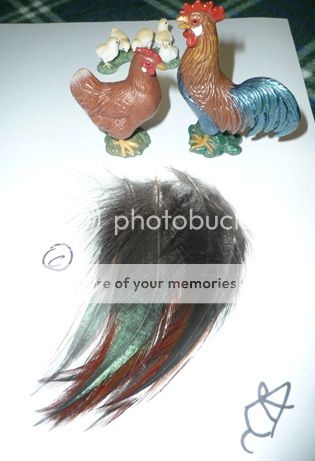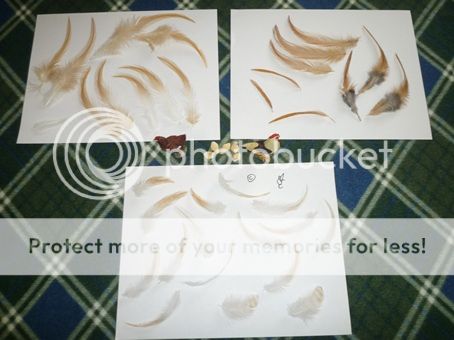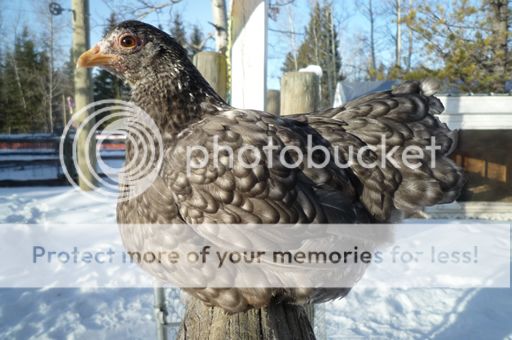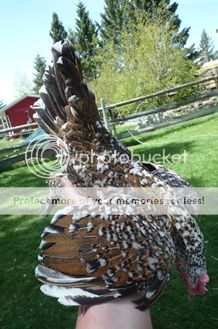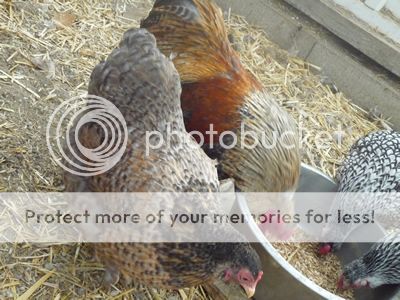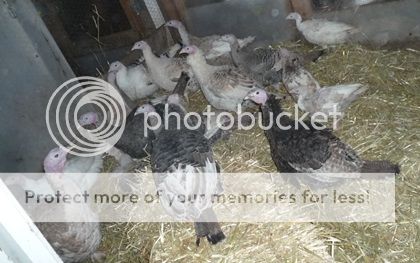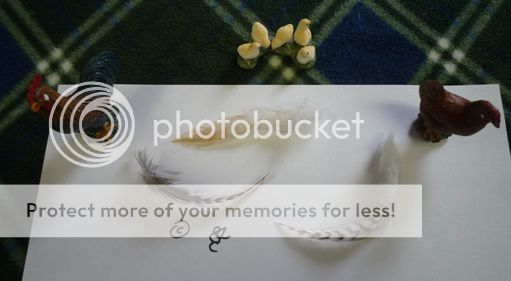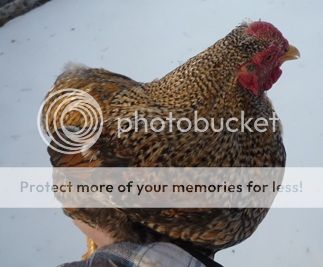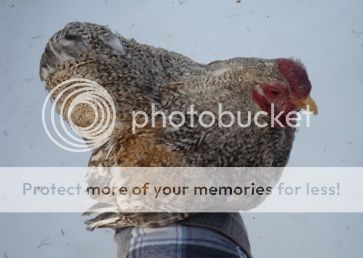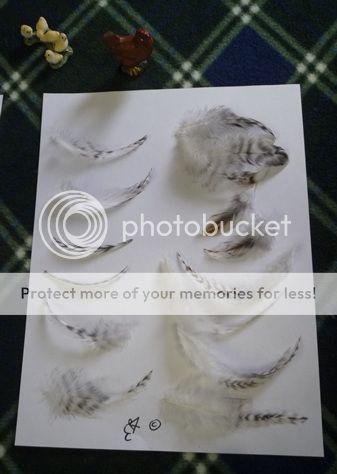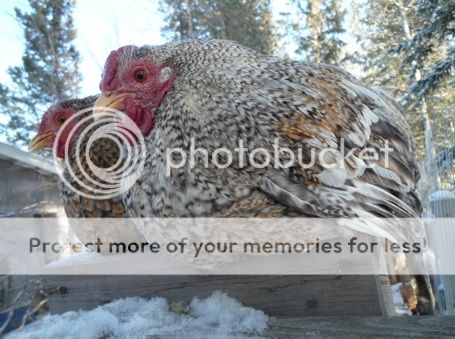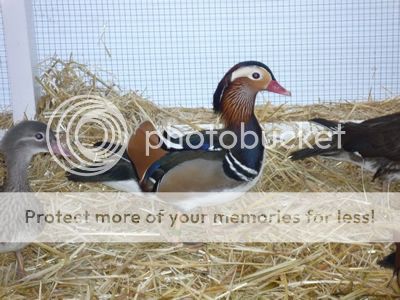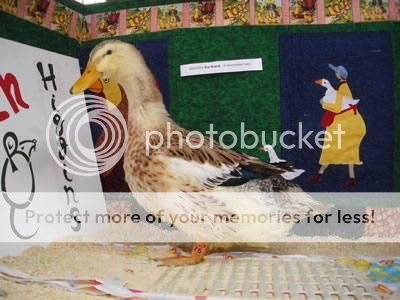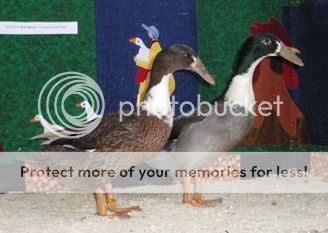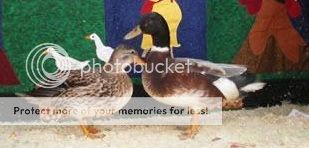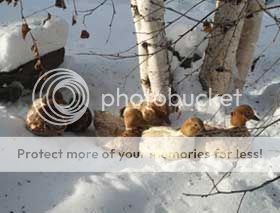canuckfeathers
Member
Heel low:
Am a retired accountant, I drive school bus to pay for bird seed so we may run a biosecure Conservation Farm in the Rocky Mountain Foothills of Alberta, Canada (yes, the gateway to some pretty fab fishing & hunting!). We have ninety years experience between us, my spouse and I, in raising livestock, canines and poultry. I love our hobby and wonder if it might supply the needs of another hobby... One fine day, I have visions of having a store front off my husband's cabinet shop that sells honest to goodness Jacob sheep wool socks & blankets, a huge assortment of feathers for fly tyers (Hackles Up), and a place to pick up a dozen Sing Brightly Happy Hen cackleberries for your out in the woods campfire breakfast. I have a dream...will it become reality...please help me to understand your hobby better!
I have a few (well OK, more than a few) questions about poultry feathers used in fly tying. Should call this thread "Feathers 101" for the one hundred and one questions I am about to ask here. Brace yourself...
I know just enough about fly tying to be a danger to myself (mostly) as I took a class in elementary school on this indepth and marvelous endeavour, even got a vice kicking around here some place too. I am more a bobber and worm kinda fisher; tom boy that grew up on the Nor end of Van Isle...you could tie a pink mini marshmallow on the end of baling twine and limit out on Sockeye--those were the good ol' dazes...abalone at low tide, feasting on prawns & crab, steelhead ripping thru the streams and cutthroats surfacing at every pond; waiting for me to come crashing thru the Salal. I never EVER got left at home because I figured the best part about fishing was cleaning the catch; figuring out what the fish were eating! Not done any fishing for decades...bin too busy playing with ducks, chickens, turkeys, pheasants, geese, swans, and various other silly creatures on the funny farm...so am thinking (danger, warning sign!) I would like to know more about what the fly tying people that use feathers want out of the poultry feathers supplied to them.
A little about colour in bird feathers...only two pigments in bird feathers; black (eumelanin) and red (phaeomelanin) and you get white when no pigment is expressed. All those really funky brilliant feather colours you see in say hummingbirds and pheasants (turkey rainbow feathers, some chickens and ducks too) are made possible when layers of bubbles top the feather's surface. Available light dictates the colours that are reflected back to our eyes, so this makes me wonder, how do those gorgeous Red Golden feathers l00k to fish underwater, dancing daintily delicious (have a bite, eh?) in the river currents or floating precariously on top? I am going to have to rely on the expertise here for guidance on what makes fish bite a fly and what you want in your fanciful feathery baits.
Quite often when messing with colours in poultry, we create unrecognized feather patterns. Last year I was beginning the makings of a large fowl breed into a bantam breed and ended up with Brockbars (red cuckoo/barred)...a variety not recognized in North America, but there are some rare ones in Europe. I see what looks like "cuckoo" patterns in alot of your flies, that and some pretty nifty flies with Red Golden pheasant feathers...nice!
I adore colour genetics and have played around with it in dogs, sheep, and now the birds. It may surprise some fishermen that we can do a fair amount of manipulation on the expressions found in poultry feathers. From shape, size, texture, colour, pattern, hard vs. soft, strong vs. weak. Did you know the strongest feathers are white (devoid of pigment)? Explains why the Black Australian Swans can be mostly black but their primary feathers need to be White for flight.
I want to know what feathers people that tie flies want. I might have alot of the kind of feathers here already that people will like and I may also be able to breed up some pretty funky colours and patterns, tailored to specific requests. This will take time, effort and luck. If I don't know what others are looking for, kinda hard to expect to be able to supply it.
I am asking the people that do the fly tying to hear right from the end users, what do you people want in your poultry feathers?
What do you currently like about the poultry feathers you can acquire?
What would you like to see changed (if possible) in the poultry feathers?
What can you imagine in feathers that would suit a need you can't find?
What are some of the most desirable qualities that are missing in poultry feathers?
Our climate here ranges from summer highs of more than +40 C down to winter lows of more than -40 C...we have the climate that encourages good insulative feather growth.
Older maturer birds produce longer feathers. Then there is different sizes bred into poultry...in chickens, standard (large fowl) and bantams, waterfowl will have weight differences in the actual breeds (Appleyards are a heavy duck, whilst Calls, Indies, Mandarins and Spots are bantam / Dutch Hookbills and Crested are a medium sized duck). In geese, swans, and game birds like pheasants, they are the size that they are though an Egyptian goose is not as robust as a more domesticated goose breed like our Americans.
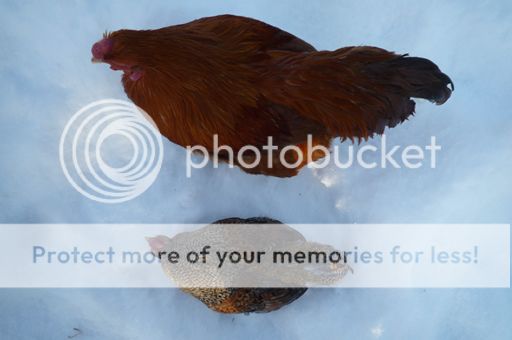
Standard chicken compared to Bantam chicken.
Top is a standard sized Chantecler chicken, bottom is a bantam sized Wyandotte chicken.
Standard chickens have longer hackles (and in the males, saddles), wings, tails...simply because a standard (large fowl) chicken is bigger than bantams. Yet on the reverse side, bantam chickens would offer finer details, more precise markings and patterns in their smaller expressed feathers. A Bronze turkey wing feather pattern may be lost if you were trying to make a small fly...selection for a bantam chicken Crele variety hackle/saddle feather might be a better choice for smaller flies.
Golden Pheasant males, at about age two years begin to display an amazing array of coloured feathers. Before this age, they look pretty much like the females (camouflage colour pattern) and you can tell they are males after a certain age as youngsters because of their yellow iris, the females are brown.

Red Golden female adult
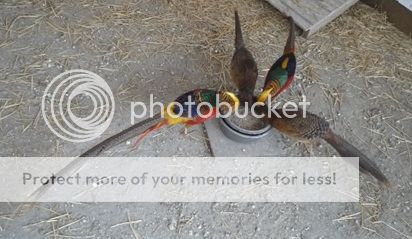

Red Golden males: Two juvenile males under two years of age with older than two year old adult males / Male Red Golden feathers.
The matured male Red Golden pheasant has vivid lustrous yellow, orange, green, blue, red, brown, black electric popping feathers. Do these colours remain this vivid UNDERWATER? Are there feather colours that are a complete waste of effort when viewed under water? I know with blue in bird plumage, that it is caused by there being ample black pigments in a feather being diluted to the colour shade of blue. These same blue feathers when viewed in the shade are grey, not blue. Look at a wild blue jay, in the shade they look grey, no blue is reflected back for us to view as that colour. What happens to the bright coloured feathers underwater, does the luster disappear? Do fishermen and fly tyers care about this?
I see offered, right and left side wing feathers, matched pairs...and of course tail feathers. I expect to hear that there are applications where you want matched left and right portions of feathers for a project fly (maybe insect wings), then other times where you would want perfectly straight grained (can I call it grained like in wood grain or is there a different fly tying terminology for left and right sided materials?) webs. I laugh as I have the Aussie Black swans and they have ruffles, yes, wavy grained/webbed pitch black feathers which might offer an interesting option to a fly tying project. Would a wavy web be something tyers might want?


Are there purists on here that figure a chemically dyed feather is taboo, or does it really matter; natural or dyed? Do the fish notice? Do you care? I know in supplying hand spinners with fleeces, the Jacobs seem to make people happy with being able to supply a bunch of different natural colours for spinning into yarn for socks, blankets, sweaters, or even just rovings for crafts, etc.
What colours do you use the most in your art form (may I call it that, it is really beautiful, the hand tied flies!); brown and black, white, yellow, orange, red, purple, green, blue?
We have self colours like Blue, Chocolate, Blacks (flat blacks, beetle green blacks), Brown, Orange, Gold, Red, Yellow, White, metallics in copper, rainbows... I could prattle on for hours here and bore paint off the walls.
What patterns? I have Pencilled (gold, silver), Laced (black, blue, golden, silver), Mille de Fleur (mahogany reds with black spangle and tipped in a white pearl), Columbian (buff/gold and silver), Cuckoo/Barred (black, red, blue), combinations like Cuckoo Columbian (Delware) or Crele, waterfowl patterns like Blue Fawn, Grey Mallard, Pastel, Snowy, Butterscotch, Bibbed, Pied, Magpie, Ancona...etc. Sure I have forgotten a few...oh well.
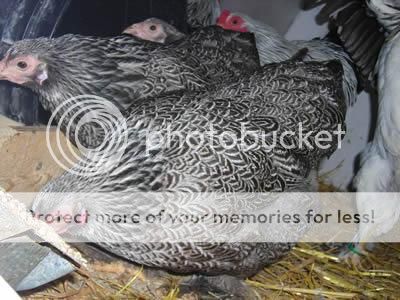


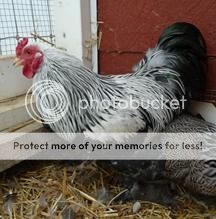


In hackle feathers, we have what I refer to as "diamonds" in the pencilled varieties, a v-shaped striped feather with a diamond shaped center. We have these in gold and silver, beetle green black edged in mahogany and red orange clay. It takes 100's of years to perfect the expression of some poultry patterns; one season from someone that selects for quantity over quality and these attributes may be lost. We imported many of our birds from oldtimers that have invested 60 and 75 years into their lines and we have gone forward with these genetics. I wonder if the same things I look for in our bird feathers are the same things fly tyers want in the feathers they use.
When feathers are collected, do the oils from human hands alter the usability? Should someone wear some sort of glove, say cotton, leather or latex? Do you bother to wear gloves when you tie the flies? Would seem silly to care about the handling and transfer if the fly tyer don't take precautions.

Various Heritage Turkey Feathers.
Looking at all the funky colour varieties we raise in say just the heritage turkeys (Jersey Buff, Wishard Bronze, Narragansett, Slate, Red Bronze, Rusty Black, Dilute Rusty Black, Red Blue Bronze, Lilac & Sweetgrass), it seems quite the shame that when I process some for our table, I toss the feathers. I will be processing a Wishard Bronze tom for Christmas dinner and maybe I should be saving these feathers as they don't do no good being thrown away. I dry pluck; I don't like processing hot, wet, feathers and oozy fats! Blick. If you harvest them humanely efficient, the feathers pluck out very clean and easy. I expect feathers harvested in this manner are much nicer to use for fly tying so won't have to adjust this method.
One of my absolute favourite turkeys for colour expression in feathers is the Rusty Black.
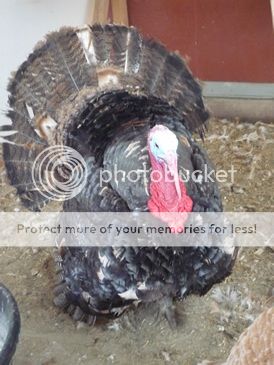
Rusty Black Tom.



Some of his feathers.
Do you people like your feathers sorted by the places on the bird's body where the feathers grow? For example; tail feathers, hackle or saddle, wing coverts, flights, chest down? And what about down, do you use that too? I am going to have to learn what parts you want the whole birds segregated into...for your ease of use, of course.
How do you like the feathers stored...in plastic sealed zip lock bags, in paper bags, in wax paper, in tin foil....what method suits you best and keeps the feathers in prime condition.
Do you want the feathers plucked or are shed feathers fine too (clean, sans poop, other nasties, and not broken/abused, this would go without saying!)?
Because I can send off a fresh plucked feather to have it DNA'd (gender, colour genetics), there must be some materials in the fresh feather's quill that they test (I can also send blood dripped on a piece of "cardboard" collection paper from a short toe nail clip). To me, this could spoil, so I am going to take a leap here and ask, do I need to pluck feathers and then age/season them, dry them out and how long is long enough...I can envision this smelly package in the mail...not good, not good at all! Because I care about the quality of life our birds enjoy, would cutting the feather off with scissors degrade the fly tying quality? Pros for bird is less pain, con is that the feather does not grow back like a plucked feather.
Do you ever get a skinned bird, feathers attached or is this just gross and going to rot and spoil? I have tawed my own sheep hides (non-iodized salt, borax, Neatsfoot oiled), elk and deer, fur on and fur off. Raw tanned and soft tanned (might be hard to tan a bird skin...ha ha ha...but they do snake skins don't they?). I ask because I truly don't know, dumb as that may sound...sorry on that!
I expect not to want to supply skin with feathers attached. I will process a bird for consumption and although my big butt tells me to lay off the skin-on poultry, I have not given in and we process the birds, skin on and cook them that way. Besides, part of conservation is to find methods to utilize live birds...harvesting an annual crop of useable feathers intrigues me whilst having to kill the contributors does not seem too overly sustainable.
So what is the deal on "hackle" feathers...found on both male and female birds, only the "saddle" feathers are on the male and I don't see much difference in the saddle compared to the hackle feathers, but I am rather wet behind the ears on these things, wanting to learn from the experts. Saddle feathers can sometimes be a larger version of the hackle...too big then?



All Chantecler Standard male chickens: Red Orange Clay (ROC) / Partridge / Buff.
So you get the same kinds of feathers but in different colours and shades.
Do you only want feathers from landfowl (chickens, pheasants, turkeys, game birds or even peafowl--peafowl raising does not interest me as they can have calls that sound like someone is getting killed, so never had any--no apologies, no herl, eh)?
Do you use waterfowl feathers (I remember reading long time ago that a Wood Duck could supply a fly tyer with most all the feathers one needs, not sure on that)? Ducks, geese, swans? Man alive I have a ton of different colours and patterns in my bantam ducks. Twenty-four different colour varieties in my Call Ducks (make a fist, add feathers and watch it flirt, waddle and quack; that about sums up a Call duck!) and the Australian Spotteds in three varieties (sorta like a Mallard but add more chocolate and then frosting...sounds more like dessert than a duck breed). We got all sorts of nifty ducks from Dutch Hookbills and Silver Appleyards right on over to East Indies (beetle green blacks) and Mandarins [Aix galericulata]--nope, no Wood ducks [Aix sponsa], no aviculture permit to keep them though at one time they did reside on our property wild until we cleared out the brush and their nesting site tree trunk got too old to hold the nestlings securely.
Dry flies and wet...my understanding, dry floats on top of water, wet would not. Is there a difference in the feathers you use then for dry flies compared to wet flies? Would a wet fly feather soak up moisture and a dry fly feather repel or do you treat the fly with some product to make them water resistant therefore "floaty?"
Are there certain kinds of feathers you use to make appropriate action in the water to attract and entice fish to bitey bite? When we raise birds, we pay attention to feather textures for breed and varieties. The hard feather expresses a crisp pattern, a soft feather expresses a fuzzy pattern - barred is hard and slow grown, cuckoo is soft and fast grown. In our extreme climate here in Central Alberta, I won't produce slow grown feathers if I can help it...get it on fast, get them covered up before they succumb to the weather.
Things like feather shape affect how the pattern is expressed; almond shaped for a Laced Sebright, blunt shaped for a Barred Plymouth Rock, round for a Golden Lace Wyandotte. Even in Gold Pencilled (Partridge pattern), width of the black lacing in the pattern varies. I see many of you use finely marked feathers for tying flies, pending how small the fly, how much detail is being attempted would legislate how intricate the pattern has to be expressed in the feathers.
When do you purchase your feathers...all year round or?
When do you do most of your fly tying? During the winter months to get a stash done up for when nicer weather is upon us and you are then busy fishing (thinking Canada weather, the Great White North right now here)?
Are there any obvious questions I have not touched upon that you might answer?
Well that was a cascade of questions. I wonder if you will simply shrug and say, too many questions...I hope not!
Thank you ever so kindly for those brave and tenacious enough to make it this far down the screen! VBG
I will post a few more times to show you some examples from the various poultry species we have in regards to feathers for fly tying.
Doggone & Hackles UP!
Tara
Am a retired accountant, I drive school bus to pay for bird seed so we may run a biosecure Conservation Farm in the Rocky Mountain Foothills of Alberta, Canada (yes, the gateway to some pretty fab fishing & hunting!). We have ninety years experience between us, my spouse and I, in raising livestock, canines and poultry. I love our hobby and wonder if it might supply the needs of another hobby... One fine day, I have visions of having a store front off my husband's cabinet shop that sells honest to goodness Jacob sheep wool socks & blankets, a huge assortment of feathers for fly tyers (Hackles Up), and a place to pick up a dozen Sing Brightly Happy Hen cackleberries for your out in the woods campfire breakfast. I have a dream...will it become reality...please help me to understand your hobby better!
I have a few (well OK, more than a few) questions about poultry feathers used in fly tying. Should call this thread "Feathers 101" for the one hundred and one questions I am about to ask here. Brace yourself...
I know just enough about fly tying to be a danger to myself (mostly) as I took a class in elementary school on this indepth and marvelous endeavour, even got a vice kicking around here some place too. I am more a bobber and worm kinda fisher; tom boy that grew up on the Nor end of Van Isle...you could tie a pink mini marshmallow on the end of baling twine and limit out on Sockeye--those were the good ol' dazes...abalone at low tide, feasting on prawns & crab, steelhead ripping thru the streams and cutthroats surfacing at every pond; waiting for me to come crashing thru the Salal. I never EVER got left at home because I figured the best part about fishing was cleaning the catch; figuring out what the fish were eating! Not done any fishing for decades...bin too busy playing with ducks, chickens, turkeys, pheasants, geese, swans, and various other silly creatures on the funny farm...so am thinking (danger, warning sign!) I would like to know more about what the fly tying people that use feathers want out of the poultry feathers supplied to them.
A little about colour in bird feathers...only two pigments in bird feathers; black (eumelanin) and red (phaeomelanin) and you get white when no pigment is expressed. All those really funky brilliant feather colours you see in say hummingbirds and pheasants (turkey rainbow feathers, some chickens and ducks too) are made possible when layers of bubbles top the feather's surface. Available light dictates the colours that are reflected back to our eyes, so this makes me wonder, how do those gorgeous Red Golden feathers l00k to fish underwater, dancing daintily delicious (have a bite, eh?) in the river currents or floating precariously on top? I am going to have to rely on the expertise here for guidance on what makes fish bite a fly and what you want in your fanciful feathery baits.
Quite often when messing with colours in poultry, we create unrecognized feather patterns. Last year I was beginning the makings of a large fowl breed into a bantam breed and ended up with Brockbars (red cuckoo/barred)...a variety not recognized in North America, but there are some rare ones in Europe. I see what looks like "cuckoo" patterns in alot of your flies, that and some pretty nifty flies with Red Golden pheasant feathers...nice!
I adore colour genetics and have played around with it in dogs, sheep, and now the birds. It may surprise some fishermen that we can do a fair amount of manipulation on the expressions found in poultry feathers. From shape, size, texture, colour, pattern, hard vs. soft, strong vs. weak. Did you know the strongest feathers are white (devoid of pigment)? Explains why the Black Australian Swans can be mostly black but their primary feathers need to be White for flight.
I want to know what feathers people that tie flies want. I might have alot of the kind of feathers here already that people will like and I may also be able to breed up some pretty funky colours and patterns, tailored to specific requests. This will take time, effort and luck. If I don't know what others are looking for, kinda hard to expect to be able to supply it.
I am asking the people that do the fly tying to hear right from the end users, what do you people want in your poultry feathers?
What do you currently like about the poultry feathers you can acquire?
What would you like to see changed (if possible) in the poultry feathers?
What can you imagine in feathers that would suit a need you can't find?
What are some of the most desirable qualities that are missing in poultry feathers?
Our climate here ranges from summer highs of more than +40 C down to winter lows of more than -40 C...we have the climate that encourages good insulative feather growth.
Older maturer birds produce longer feathers. Then there is different sizes bred into poultry...in chickens, standard (large fowl) and bantams, waterfowl will have weight differences in the actual breeds (Appleyards are a heavy duck, whilst Calls, Indies, Mandarins and Spots are bantam / Dutch Hookbills and Crested are a medium sized duck). In geese, swans, and game birds like pheasants, they are the size that they are though an Egyptian goose is not as robust as a more domesticated goose breed like our Americans.

Standard chicken compared to Bantam chicken.
Top is a standard sized Chantecler chicken, bottom is a bantam sized Wyandotte chicken.
Standard chickens have longer hackles (and in the males, saddles), wings, tails...simply because a standard (large fowl) chicken is bigger than bantams. Yet on the reverse side, bantam chickens would offer finer details, more precise markings and patterns in their smaller expressed feathers. A Bronze turkey wing feather pattern may be lost if you were trying to make a small fly...selection for a bantam chicken Crele variety hackle/saddle feather might be a better choice for smaller flies.
Golden Pheasant males, at about age two years begin to display an amazing array of coloured feathers. Before this age, they look pretty much like the females (camouflage colour pattern) and you can tell they are males after a certain age as youngsters because of their yellow iris, the females are brown.

Red Golden female adult


Red Golden males: Two juvenile males under two years of age with older than two year old adult males / Male Red Golden feathers.
The matured male Red Golden pheasant has vivid lustrous yellow, orange, green, blue, red, brown, black electric popping feathers. Do these colours remain this vivid UNDERWATER? Are there feather colours that are a complete waste of effort when viewed under water? I know with blue in bird plumage, that it is caused by there being ample black pigments in a feather being diluted to the colour shade of blue. These same blue feathers when viewed in the shade are grey, not blue. Look at a wild blue jay, in the shade they look grey, no blue is reflected back for us to view as that colour. What happens to the bright coloured feathers underwater, does the luster disappear? Do fishermen and fly tyers care about this?
I see offered, right and left side wing feathers, matched pairs...and of course tail feathers. I expect to hear that there are applications where you want matched left and right portions of feathers for a project fly (maybe insect wings), then other times where you would want perfectly straight grained (can I call it grained like in wood grain or is there a different fly tying terminology for left and right sided materials?) webs. I laugh as I have the Aussie Black swans and they have ruffles, yes, wavy grained/webbed pitch black feathers which might offer an interesting option to a fly tying project. Would a wavy web be something tyers might want?


Are there purists on here that figure a chemically dyed feather is taboo, or does it really matter; natural or dyed? Do the fish notice? Do you care? I know in supplying hand spinners with fleeces, the Jacobs seem to make people happy with being able to supply a bunch of different natural colours for spinning into yarn for socks, blankets, sweaters, or even just rovings for crafts, etc.
What colours do you use the most in your art form (may I call it that, it is really beautiful, the hand tied flies!); brown and black, white, yellow, orange, red, purple, green, blue?
We have self colours like Blue, Chocolate, Blacks (flat blacks, beetle green blacks), Brown, Orange, Gold, Red, Yellow, White, metallics in copper, rainbows... I could prattle on for hours here and bore paint off the walls.
What patterns? I have Pencilled (gold, silver), Laced (black, blue, golden, silver), Mille de Fleur (mahogany reds with black spangle and tipped in a white pearl), Columbian (buff/gold and silver), Cuckoo/Barred (black, red, blue), combinations like Cuckoo Columbian (Delware) or Crele, waterfowl patterns like Blue Fawn, Grey Mallard, Pastel, Snowy, Butterscotch, Bibbed, Pied, Magpie, Ancona...etc. Sure I have forgotten a few...oh well.






In hackle feathers, we have what I refer to as "diamonds" in the pencilled varieties, a v-shaped striped feather with a diamond shaped center. We have these in gold and silver, beetle green black edged in mahogany and red orange clay. It takes 100's of years to perfect the expression of some poultry patterns; one season from someone that selects for quantity over quality and these attributes may be lost. We imported many of our birds from oldtimers that have invested 60 and 75 years into their lines and we have gone forward with these genetics. I wonder if the same things I look for in our bird feathers are the same things fly tyers want in the feathers they use.
When feathers are collected, do the oils from human hands alter the usability? Should someone wear some sort of glove, say cotton, leather or latex? Do you bother to wear gloves when you tie the flies? Would seem silly to care about the handling and transfer if the fly tyer don't take precautions.

Various Heritage Turkey Feathers.
Looking at all the funky colour varieties we raise in say just the heritage turkeys (Jersey Buff, Wishard Bronze, Narragansett, Slate, Red Bronze, Rusty Black, Dilute Rusty Black, Red Blue Bronze, Lilac & Sweetgrass), it seems quite the shame that when I process some for our table, I toss the feathers. I will be processing a Wishard Bronze tom for Christmas dinner and maybe I should be saving these feathers as they don't do no good being thrown away. I dry pluck; I don't like processing hot, wet, feathers and oozy fats! Blick. If you harvest them humanely efficient, the feathers pluck out very clean and easy. I expect feathers harvested in this manner are much nicer to use for fly tying so won't have to adjust this method.
One of my absolute favourite turkeys for colour expression in feathers is the Rusty Black.

Rusty Black Tom.



Some of his feathers.
Do you people like your feathers sorted by the places on the bird's body where the feathers grow? For example; tail feathers, hackle or saddle, wing coverts, flights, chest down? And what about down, do you use that too? I am going to have to learn what parts you want the whole birds segregated into...for your ease of use, of course.
How do you like the feathers stored...in plastic sealed zip lock bags, in paper bags, in wax paper, in tin foil....what method suits you best and keeps the feathers in prime condition.
Do you want the feathers plucked or are shed feathers fine too (clean, sans poop, other nasties, and not broken/abused, this would go without saying!)?
Because I can send off a fresh plucked feather to have it DNA'd (gender, colour genetics), there must be some materials in the fresh feather's quill that they test (I can also send blood dripped on a piece of "cardboard" collection paper from a short toe nail clip). To me, this could spoil, so I am going to take a leap here and ask, do I need to pluck feathers and then age/season them, dry them out and how long is long enough...I can envision this smelly package in the mail...not good, not good at all! Because I care about the quality of life our birds enjoy, would cutting the feather off with scissors degrade the fly tying quality? Pros for bird is less pain, con is that the feather does not grow back like a plucked feather.
Do you ever get a skinned bird, feathers attached or is this just gross and going to rot and spoil? I have tawed my own sheep hides (non-iodized salt, borax, Neatsfoot oiled), elk and deer, fur on and fur off. Raw tanned and soft tanned (might be hard to tan a bird skin...ha ha ha...but they do snake skins don't they?). I ask because I truly don't know, dumb as that may sound...sorry on that!
I expect not to want to supply skin with feathers attached. I will process a bird for consumption and although my big butt tells me to lay off the skin-on poultry, I have not given in and we process the birds, skin on and cook them that way. Besides, part of conservation is to find methods to utilize live birds...harvesting an annual crop of useable feathers intrigues me whilst having to kill the contributors does not seem too overly sustainable.
So what is the deal on "hackle" feathers...found on both male and female birds, only the "saddle" feathers are on the male and I don't see much difference in the saddle compared to the hackle feathers, but I am rather wet behind the ears on these things, wanting to learn from the experts. Saddle feathers can sometimes be a larger version of the hackle...too big then?



All Chantecler Standard male chickens: Red Orange Clay (ROC) / Partridge / Buff.
So you get the same kinds of feathers but in different colours and shades.
Do you only want feathers from landfowl (chickens, pheasants, turkeys, game birds or even peafowl--peafowl raising does not interest me as they can have calls that sound like someone is getting killed, so never had any--no apologies, no herl, eh)?
Do you use waterfowl feathers (I remember reading long time ago that a Wood Duck could supply a fly tyer with most all the feathers one needs, not sure on that)? Ducks, geese, swans? Man alive I have a ton of different colours and patterns in my bantam ducks. Twenty-four different colour varieties in my Call Ducks (make a fist, add feathers and watch it flirt, waddle and quack; that about sums up a Call duck!) and the Australian Spotteds in three varieties (sorta like a Mallard but add more chocolate and then frosting...sounds more like dessert than a duck breed). We got all sorts of nifty ducks from Dutch Hookbills and Silver Appleyards right on over to East Indies (beetle green blacks) and Mandarins [Aix galericulata]--nope, no Wood ducks [Aix sponsa], no aviculture permit to keep them though at one time they did reside on our property wild until we cleared out the brush and their nesting site tree trunk got too old to hold the nestlings securely.
Dry flies and wet...my understanding, dry floats on top of water, wet would not. Is there a difference in the feathers you use then for dry flies compared to wet flies? Would a wet fly feather soak up moisture and a dry fly feather repel or do you treat the fly with some product to make them water resistant therefore "floaty?"
Are there certain kinds of feathers you use to make appropriate action in the water to attract and entice fish to bitey bite? When we raise birds, we pay attention to feather textures for breed and varieties. The hard feather expresses a crisp pattern, a soft feather expresses a fuzzy pattern - barred is hard and slow grown, cuckoo is soft and fast grown. In our extreme climate here in Central Alberta, I won't produce slow grown feathers if I can help it...get it on fast, get them covered up before they succumb to the weather.
Things like feather shape affect how the pattern is expressed; almond shaped for a Laced Sebright, blunt shaped for a Barred Plymouth Rock, round for a Golden Lace Wyandotte. Even in Gold Pencilled (Partridge pattern), width of the black lacing in the pattern varies. I see many of you use finely marked feathers for tying flies, pending how small the fly, how much detail is being attempted would legislate how intricate the pattern has to be expressed in the feathers.
When do you purchase your feathers...all year round or?
When do you do most of your fly tying? During the winter months to get a stash done up for when nicer weather is upon us and you are then busy fishing (thinking Canada weather, the Great White North right now here)?
Are there any obvious questions I have not touched upon that you might answer?
Well that was a cascade of questions. I wonder if you will simply shrug and say, too many questions...I hope not!
Thank you ever so kindly for those brave and tenacious enough to make it this far down the screen! VBG
I will post a few more times to show you some examples from the various poultry species we have in regards to feathers for fly tying.
Doggone & Hackles UP!
Tara

